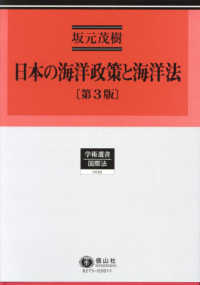Full Description
This book, part of the European Society of Intensive Care Medicine textbook series, teaches readers how to use hemodynamic monitoring, an essential skill for today's intensivists. It offers a valuable guide for beginners, as well as for experienced intensivists who want to hone their skills, helping both groups detect an inadequacy of perfusion and make the right choices to achieve the main goal of hemodynamic monitoring in the critically ill, i.e., to correctly assess the cardiovascular system and its response to tissue oxygen demands.
The book is divided into distinguished sections: from physiology to pathophysiology; clinical assessment and measurements; and clinical practice achievements including techniques, the basic goals in clinical practice as well as the more appropriate hemodynamic therapy to be applied in different conditions. All chapters use a learning-oriented style, with practical examples, key points and take home messages, helping readers quickly absorbthe content and, at the same time, apply what they have learned in the clinical setting.
The European Society of Intensive Care Medicine has developed the Lessons from the ICU series with the vision of providing focused and state-of-the-art overviews of central topics in Intensive Care and optimal resources for clinicians working in Intensive Care.
Contents
Introduction (Jukka Takala).- Part I. Physiology and Pathophysiology.- Chapter 1. Shock: definition and recognition (Massimo Antonelli).- Chapter 2. Assessing the adequacy of cardiac output (Jean-Louis Vincent).- Chapter 3. The determinants of Venous Return (Maurizio Cecconi).- Chapter 4. Arterial blood Pressure Regulation (Michel Pinsky).- Chapter 5. Pulmonary Circulation (Marco Maggiorini).- Chapter 6. Heart Rate (Paul Marik).- Chapter 7. Autonomic Dysfunction in Shock (Gareth Ackland).- Chapter 8. Oxygen Delivery (Luciano Gattinoni).- Chapter 9. Mitochondrial Function (Mervyn Singer).- Chapter 10. Perioperative Hemodynamics (Andrew Rhodes).- Chapter 11. Haemodynamics and Extracorporeal Circulation (Alain Combes).- Part II. Clinical Assessment and Measurements.- Chapter 12. Clinical Assessment of Hemodynamic Instability (Jan Bakker).- Chapter 13. Assessment of the microcirculation (Daniel De Backer).- Chapter 14. SvO2/ScVO2 (Zsolt Molnar).- Chapter 15. pcO2 gap (Ospina-Tascon).- Chapter 16. Lactate (Glenn Hernandez).- Part III. The Techniques.- Chapter 17. Cardiac Ultrasound Examination in Shock (Antoine Viellard Baron).- Chapter 18. Non Cardiac Ultrasound Signs in Shock (Paul Mayo).- Chapter 19. Central Venous Pressure (Sheldon Magder).- Chapter 20. Arterial Blood Pressure (Jean-Louis Teboul).- Chapter 21. Cardiac Output Monitors (Daniel Reuter).- Chapter 22. Volumetric Monitoring (Manu Malbrain).- Chapter 23. Assessment of Fluid Responsiveness (Xavier Monnet).- Chapter 24. Pulmonary Arterial Catheter (Didier Payen).- Chapter 25. Arterial Pressure Waveform Analysis Cardiac Output Monitoring (Ignacio Monge Garcia).- Chapter 26. Oesophageal Doppler (Monty Mythen).- Chapter 27. Bioimpedence / Bioreactance (Pierre Squara).- Chapter 28. Other Techniques (Jacques Duranteau).- Part IV. Basic Goals in Clinical Practice.-Chapter 29. Blood Pressure Targets in the initial stabilization (Pierre Asfar).- Chapter 30. Choosing the right vasopressor (Anthony Gordon).- Chapter31. Fluid Resuscitation (Anders Perner).- Part V. Choosing the Right Hemodynamic Therapy.- Chapter 32. In Acute Heart Failure (Alexandre Mebazaa).- Chapter 33. In Septic Shock(Claude Martin).- Chapter 34. In ARDS (Luciano Gattinoni).- Chapter 35. In Neurological Emergencies (Fabio Taccone).- Chapter 36. For Perioperative Optimisation (Rupert Pearse).- Chapter 37. In a Patient under ECMO (Richard Beale).








